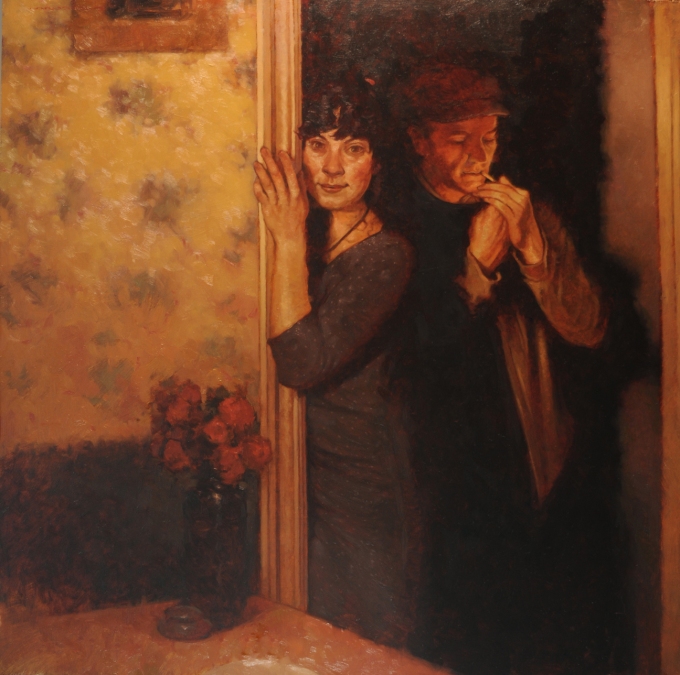Recently, we asked a number of our artists to write and share their takes on what their art means to them. We hope to give you the chance to connect with the artists in the same way they hope to connect with you through their paintings. With this post, the talented artist, Joseph Lorusso, explains his inspirations and what he desires to accomplish with his work.
Every Picture Tells a Story
Whenever I visit a museum or gallery, as most of us do, I find myself gravitating towards certain types of paintings. For me there are obvious reasons causing this gravitational draw – to try and unlock some technical secrets a great artist might be hiding, to discern how the artist was able to achieve certain effects, to admire their mastery of drawing, etc.
“But in the larger scope , I’ve always found myself drawn to works that tell a story.”
From my first days of artistic training, I was always drawn to the great illustrators who painted narrative scenes to support a story, such as N.C. Wyeth , Norman Rockwell, Howard Pyle, and Maxfield Parrish to name a few. Upon further self- education, I realized that great story telling was really at the core of all art. In essence, one of the first ways “modern” humans where able to communicate was to tell their stories through art – as evidenced by the now famous Lascaux cave paintings in France and elsewhere around the world. These first images illustrated daily life, including hunting and religious rituals, all in attempt to hand down our human experience long before we were able to develop a workable language or alphabet.
As humans developed and time passed, the technical side of this storytelling may have advanced, but the meaning and reason, I contend, remains the same – we have the need to connect. Visual language and storytelling are ways in which we achieve that. It is no mystery that going to a museum or gallery leaves many people with a spiritual experience in many ways; it allows us communion with a deeper sense of ourselves.
The visual artist, in my opinion, has a unique opportunity to create the world he wishes, and often finds that his world is also shared by others in need of the same type of outlet or escape. In my work, my goal is to give the viewer a starting point, a springboard from which they can then expand the narrative by adding or reflecting their own experiences. For me, this is the essence of image making in whatever form you choose as your vehicle.
Over the years as a visual artist, I have found myself drawn to various types of scenes, but mostly scenes that involve a strong emotional theme, usually romantic or passionate scenes that seem to resonate with viewers. Some examples of this are paintings that depict scenes of everyday life that most of us not only can relate to but may actually have experienced. Paintings, such as “The Long Fare,” shows a couple either saying hello or goodbye, making the most of the moment, while their taxi awaits them.

“The Long Fare,” 26×24, oil on panel, Gallery #16666
Not all scenes need to be romantic in nature to express a strong emotion or mood. A particular scene I enjoyed creating was the painting “After Hours;” a man and a woman stand in a dark doorway as she gazes invitingly toward the viewer, while the man stands behind her, mostly in shadow, his face only lit by the glow of a match intended to light his cigarette. The intent of the piece is meant to be mysterious and engaging, suggesting overtones of a darker side of life, nevertheless allowing the viewer room for interpretation.

“After Hours,” 30×30, oil on panel, Gallery #CS30805
Another great example of work that resonates with others is the painting “After the Bath,” in which I depict a very personal scene from my own life. Here, my wife and oldest daughter are getting ready for bed for their night time ritual. While this is a common scene in many ways, it is universal and touches a chord with most people in its sensitivity and intimacy. We all in some ways can relate to scenes like these because of our shared human experience, thus allowing us to connect through the dignity and commonality of our daily lives.

“After the Bath,” 21×14, oil on panel, Private Collection
Ultimately, my goal as a painter is to bring all aspects of the composition together, from technical to aesthetic, in order to create the strongest and most effective statement. My work has been called nostalgic in many ways, though not by intention – perhaps we all are naturally drawn to images that evoke simpler, more “idealized” times. In many ways, the era depicted in my paintings is almost arbitrary, as the emotion and story remains universal. A good example of this is the painting “Waiting at the Station.” Here, I challenge myself technically and compositionally by creating a larger composition all while trying to set several potential stories into one scene. The goal was to keep the viewer engaged by moving through the scene from story to story, yet remain in one setting.

“Waiting at the Station,” 48×48, oil on panel, Gallery #16627
Fortunately, we as people will always have stories to tell and emotions to express, giving me ample opportunity to create more work than I can hope for in several lifetimes. Hopefully, the work I am creating will continue to have resonance with its viewers.
“For me, it is this personalized connection that is the true test of the piece’s success, which in turn completes my painting.”
-Joseph Lorusso
To view all of the works we have by Joseph Lorusso, click this link! And stay tuned with our blog to see which artist takes it over next!


